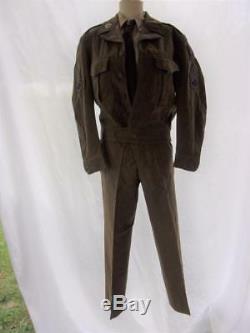WWII Complete Uniform Ike Jacket Pants Shirt Tie Cap $375.95


Below you will find a description of each piece. The M-44 jacket was fundamentally a waist-length M-43, w/some improvements. Made of olive drab 18-ounce wool. "Storm collar", snag-free "fly front" buttons and flapped, bellows breast pockets, epaulets for gear retention, and roomy sleeves to accommodate insulating layers. Staggered cuff buttons adjusted for layering or allowed a loose fit in warmer conditions, as did adjustable waist buckles. A pair of "action-back" pleats extended from shoulder to waistband, providing freedom of movement with a slim fit. Intended to be worn on its own or underneath the M-43, the "Ike jacket", was classified standard issue in November 1944, and additionally designated as the Armys dress and parade uniform. Jacket has 2 shoulder patches on each side. The Flaming Sword patch was modeled on that of the 2nd U. Division Memorial (1917-18) in Washington. Ike approved the badge when he assumed command, and in March. It came into general use as the headquarters shoulder patch and vehicle mark.
The flaming sword of freedom cuts the black of the Nazi night over Europe and points the way to the final rainbow of peace and liberty. The rainbow is made up of the colors of the Allied nation, a staff sergeant patch which designates the US Army enlisted rank. On the collar is a silver domed US collar disk. The shirt is khaki i. Light tan (#1 after March 30, 1944) cotton shirt.
Buttoned up rather than the earlier pullover placket-style shirt, it had an attached collar, six or seven buttons (according to length), single buttons at the cuffs, shoulder straps let in at the shoulder seam and buttoned at the collar end, and two breast patch pockets with buttoned flap. The flaps were straight across with the bottom corners clipped at 45 degree angles.
The shoulder strap was about 2 inches at the shoulder, drawn to a 1¼ inch rounded point at the collar end. The shoulder end was cross-stitched to the shoulder for two inches.All buttons were khaki, in a shade slightly darker than the fabric. Initially, the shirts were made of 8.2 ounce cotton; however, 6- ounce was introduced in 1941 and 5- ounce in early 1945.
This shirt would be worn with either Class A or Class C uniforms. Shirt has same badges on sleeves as the jacket, missing 1 shoulder strap button. Barathea is a hopsack twill weave that has a lightly ribbed or pebbled weave often used for mens evening wear; elastique is similar to cavalry twill. The trousers had plain, unpleated fronts and plain cuffs (without turn-ups), two rear hip pockets, two side slash pockets, a watch pocket to the front of the right hip, belt loops, and a buttoned fly.
They were lined with white cotton duck. The March 30, 1944, amendment to regulations specified that the trousers had wide belt loops and that the hip pockets had buttoned flaps.
For summer, tropical, or garrison wear, an officer could wear khaki (#1) wool gabardine or cotton twill trousers otherwise identical to the olive drab or pink trousers (Class C). Pants are standard issue button fly, adjustable, I think the waist is 28, kinda faded.
The necktie until 1940, a plain black silk tie, without stripe or figure according to regulations, was worn with Class A and Class B uniforms. In 1940, it was changed to black wool, in November 1941 to either black or khaki, and in September 1943, to khaki #5 cotton mohair. The khaki cotton tie was worn with Class C dress beginning in 1939.
Older ties continued to be worn until stocks were exhausted, so officers could be seen wearing either black or khaki ties during the War. In 1948, a dark olive drab (#51) cotton mohair tie replaced the khaki one for Class A and B uniforms.In turn, it was replaced in May 1957 by the return of plain black, in tropical worsted or similar woven fabric. All personnel wore the tie tucked into the shirt, between the third and fourth buttons.
Necktie is dark olive, seam has come loose toward the ends. The Garrison or Overseas Cap. Reintroduced in 1925 for use by Army Air Corps pilots and for armored and mechanized cavalry units in 1933, by wartime, the garrison cap was authorized for wear by all officers. It was intended for use in the field (despite its name). The cap was a flat fore-and-aft envelope with a crown with an indented fore-and-aft fold and a curtain with a diagonal flap on the left, without a visor.It was made in dark olive drab (#51) for use with the service uniform and in khaki (#1) cotton mohair for use with the summer or Class C uniforms. Cap is as described above, no size found. SIZE: PANTS 28 INSEAM 31. Auctiva Offers Free Image Hosting and Editing.
Attention Sellers - Get Templates Image Hosting, Scheduling at Auctiva. The item "WWII Complete Uniform Ike Jacket Pants Shirt Tie Cap $375.95" is in sale since Wednesday, April 10, 2019. This item is in the category "Collectibles\Militaria\WW II (1939-45)\Original Period Items\United States\Uniforms". The seller is "xdmedia" and is located in Pulaski, Virginia. This item can be shipped worldwide.

